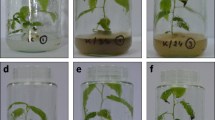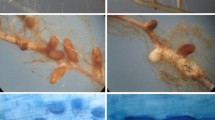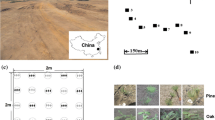Summary
Roots of two year old willow and poplar planted as cuttings in copper and iron mine tailings were stained intact and examined microscopically for mycorrhizal development. Incidence of mycorrhizae was related to tree vigor and to chemical and physical properties of the tailings. Results showed that no mycorrhizal development occurred on roots of these tree species in the copper tailings; inoculations with natural forest soil extract failed to initiate this symbiosis. Tops and roots of the willow and poplar were stunted and survival was poor. Roots in the iron mine tailings developed extensive ectomycorrhizae and trees showed good growth. Presence of mycorrhizae was confirmed and external morphology examined with the scanning electron microscope. Aseptic jack pine and naturally mycorrhizal white pine roots were used in microscopic comparisons with the hardwoods. re]19760220
Similar content being viewed by others
References
Bevege, D. I., A rapid technique for clearing tannins and staining intact roots for detection of mycorrhizae caused by Endogone spp., and some records of infection in Australian plants. Trans. Br. Mycol. Soc. 51, 808–811 (1968).
Bjorkman, E., Forest tree mycorrhiza — the conditions for its formation and significance for tree growth and afforestation. Plant and Soil 32, 589–610 (1970).
Black, C. A., Evans, D. D., White, J. L., Ensminger, L. E. and Clark, F. E., Methods of Soil Analysis. Part 2. Chemical and Microbiological Properties. Am. Soc. Agron., Madison. 1572 pp. (1965).
Campbell, R. and Rovira, A. D., The study of the rhizosphere by scanning electron microscopy. Soil Biol. Biochem. 5, 747–752 (1973).
Dean, K. C. and Havens, R., Stabilization of mineral wastes from processing plants. Proc. 2nd. Mineral Waste Symp. (1970).
Dean, K. C., Stabilizing mineral wastes. Eng. Min. J. 172, 99–103 (1971).
Hacskaylo, E., Mycorrhizae: The ultimate in reciprocal parasitism? Bio Science 22, 577–582 (1972).
Hesterberg, G. A. and Jurgensen, M. F., The relation of forest fertilization to disease incidence. For. Chron. 78, 92–95 (1972).
Harley, J. L., The Biology of Mycorrhiza. Leonard Hill, London. 334 p. (1969).
Johansen, D. A., Plant Microtechnique. McGraw-Hill Book Co., New York. 523 pp. (1940).
Marx, D. H., Bryan, W. C. and Davey, C. B., Influence of temperature on aseptic synthesis of ectomycorrhizae by Thelephora terrestris and Pisolithus tinctorius on loblolly pine. For. Sci. 16, 424–431 (1970).
Marx, D. H. and Zak, B., Effect of pH on mycorrhizal formation of slash pine in aseptic culture. For. Sci. 11, 66–75 (1965).
Mikola, P., Mycorrhizal symbiosis in forestry practice. In Ectomycorrhizae-Their Ecology and Physiology. G. C., Marks and T. T., Kozlowski (eds.). Academic Press, New York and London, 444 p. (1973).
Natrella, M. G., Experimental Statistics. National Bureau of Standards (1963).
Neilson, R. F. and Peterson, H. B., Treatment of mine tailings to promote vegetative stabilization. Agric. Exp. Sta. Utah State Univ. Bull. 485, p. 1–22 (1972).
Shetron, S. G. and Duffek, R., Establishing vegetation on iron mine tailings. J. Soil Water Conserv. 25, 227–230 (1970).
Shetron, S. G., Jones, L. and Prather, J., Establishing vegetation on alkali iron and copper tailings. III. Treatment to promote vegetation. Submitted for publication (1975).
Shipton, W. A. and Brown, J. F., A whole-leaf clearing and staining technique to demonstrate host-pathogen relationships of wheat stem rust. Phytopathology. 52, 1313 (1962).
Schramm, J. R., Plant colonization studies on black wastes from anthracite mining in Pennsylvania. In Trans. Amer. Philosoph. Soc. New Series, Vol 56, Part I (1966).
Trappe, J. M., Stahyl, E. A., Benson, N. R. and Duff, D. M., Mycorrhizal deficiency of apply trees in high arsenic soils. Hort. Science. 8, 52–53 (1973).
Vozzo, J. A. and Hacskaylo E., Inoculation of Pinus caribaea with ectomycorrhizal fungi in Puerto Rico. For. Sci. 17, 239–245.
Wilson, H. A., The microbiology of strip-mine spoil. West Virginia Univ. Agr. Exp. Sta. Bull. 505T, 44 pp. (1965).
Author information
Authors and Affiliations
Rights and permissions
About this article
Cite this article
Harris, M.M., Jurgensen, M.F. Development of salix and populus mycorrhizae in metallic mine tailings. Plant Soil 47, 509–517 (1977). https://doi.org/10.1007/BF00011507
Received:
Issue Date:
DOI: https://doi.org/10.1007/BF00011507




